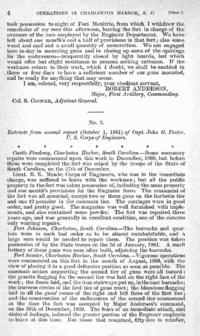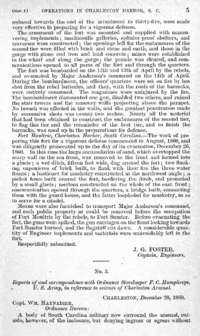
Click for full-sized scanned image

Click for full-sized scanned image
Extracts from annual report (October 1, 1861) of Captain John G. Foster, U.S. Corps of Engineers
...
Castle Pinckney, Charleston Harbor, South Carolina. - Some necessary repairs were commenced upon this work in December, 1860, but before these were completed the fort was seized by the troops of the State of South Carolina, on the 27th of December.
Lieutenant R. K. Meade, Corps of Engineers, who was in the immediate charge, was suffered to leave with the workmen; but all the public property in the fort was taken possession of, including the mess property and one month's provisions for the Engineer force. The armament of the fort was all mounted, except two or three guns on the barbette tier and one 42-pounder in the casemate tier. The carriages were in good order, and pretty good. The magazine was well furnished with implements, and also contained some powder. The fort was repaired three years ago, and was generally in excellent condition, one of the cisterns only wanting repairs.
Fort Johnson, Charleston, South Carolina. - The barracks and quarters were in such bad order as to be almost uninhabitable, and a large sum would be needed to repair them. The position was taken possession of by the State troops on the 2nd of January, 1861. A small battery of three guns was soon after built, adjoining the barracks.
Fort Sumter, Charleston Harbor, South Carolina. - Vigorous operations were commenced on this fort in the month of August, 1860, with the view of placing it in a good defensive position as soon as possible. The casemate arches supporting the second tier of guns were all turned; the granite flagging for the second tier was laid on the right face of the work; the floors laid, and the iron stairways put up, in the east barracks; the traverse circles of the first tier of guns reset; the bluestone flagging laid in all the guns' rooms of the right and left faces of the first tier; and the construction of the embrasures of the second tier commenced at the time the fort was occupied by Major Anderson's command, on the 26th of December, 1860. The fears of an immediate attack, and disloyal feelings, induced the greater portion of the Engineer employes to leave at this time. But those that remained, fifty-five in number, reduced towards the end of the investment to thirty-five, were made very effective in preparing for a vigorous defense.
The armament of the fort was mounted and supplied with maneuvering implements; machicoulis galleries, splinter-proof shelters, and traverses were constructed; the openings left for the embrasures of the second tier were filled with brick and stone and earth, and those in the gorge with stone and iron and lead concrete; mines were established in the wharf and along the gorge; the parade was cleared, and communications opened to all parts of the fort and through the quarters.
The fort was bombarded on the 12th and 13th of April by the rebels, and evacuated by Major Anderson's command on the 14th of April. During the bombardment, the officers' quarters were set on fire by hot shot from the rebel batteries, and they, with the roofs of the barracks, were entirely consumed. The magazines were uninjured by the fire. The bombardment dismounted one gun, disabled two others, and ruined the stair towers and the masonry walls projecting above the parapet. No breach was effected in the walls, and the greatest penetration made by successive shots was twenty-two inches. Nearly all the material that had been obtained to construct the embrasures of the second tier, to flag this tier and the remainder of the first tier, and to finish the barracks, was used up in the preparations for defense.
Fort Moultrie, Charleston Harbor, South Carolina. - The work of preparing this fort for a vigorous defense commenced in August, 1860, and was diligently prosecuted up the day of its evacuation, December 26, 1860. In this time the large accumulation of sand, which overtopped the scarp wall on the sea front, was removed to the front and formed into a glacis; a wet ditch, fifteen feet wide, dug around the fort; two flanking caponieres of brick built, to flank with their fire the three water fronts; a bastioned for musketry constructed at the northwest angle; a picket fence built around the fort, bordering the ditch, and protected by a small glacis; merlons constructed on the whole of the east front; communication opened through the quarters, a bridge built, connecting them with the guard-house, and the latter looppholed for musketry, so as to serve for a citadel.
Means were also furnished to transport Major Anderson's command, and such public property as could be removed before the occupation of Fort Moultrie by the rebels, to Fort Sumter. Before evacuating the fort, the guns were spiked, the gun carriages on the front looking towards Fort Sumter burned, and the flagstaff cut down. A considerable quantity of Engineer implements and materials were unavoidably left in the fort.
Respectfully submitted.
J.G. FOSTER,
Captain, Engineers.
(To view this page in its Source Category, click HERE for Part 1 and HERE for Part 2)